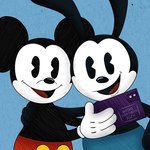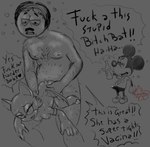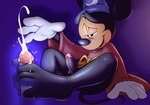
Character: mickey mouse
post #1348277 post #1390753 post #1390732
Mickey Mouse is a cartoon character and the official mascot of The Walt Disney Company, originally created by Walt Disney and Ub Iwerks in 1928.
An anthropomorphic mouse who typically wears red shorts, large yellow shoes, and white gloves in their shows, games, and movies, Mickey has become one of the most recognizable cartoon characters in the world.
Creation and Debut:
Mickey Mouse was originally created to serve as a replacement of Walt's previous character Oswald the Lucky Rabbit. The previous star was removed from the then up-and-coming Walt Disney Studio by the character's former owner Universal Pictures in 1928. Charles Mintz served as a middleman producer between Disney and Universal through his company, Winkler Pictures, for the series of cartoons starring Oswald. Ongoing conflicts between Disney and Mintz and the former's staff moving over to Winkler resulted him to cut ties from Universal, leaving only Walt, Iwerks and the remaining staff of the studio.
Mickey's creation was a secret while Disney produced the last Oswald shorts that he had contracted over with Mintz, and asked Iwerks to draw a few sketches of various animals. One of those was a frog (which later became Iwerk's creation, Flip the Frog), but was rejected. Since Walt got the inspiration from a tame mouse that he had kept during his times at the Laugh-O-Gram Studio, it inspired Iwerks to sketch out a mouse character for him. Walt thought of giving the name "Mortimer Mouse" to the character, but his wife Lillian suggested it would be better enough to have him be called "Mickey Mouse."
Mickey Mouse was first sighted in a test screening of the short film Plane Crazy, on May 15, 1928. It failed to amuse an audience and Walt was not able to find a distributor for the short. Walt then went on to produce a second Mickey short, The Gallopin' Gaucho, but was also not released for a lack of a distributor.
However, Mickey made an official debut in the third cartoon produced, Steamboat Willie, which was a parody of the Buster Keaton film Steamboat Bill, Jr.. It is often erroneously cited as the first cartoon produced with sound — the first actually being My Old Kentucky Home by the Fleischer Studios in 1926 — but it is publicly noted as being the first cartoon to have sound made in post-production.
As sound in movies (or "talkies") begin to dominate the film industry by the late 1920s, Steamboat Willie garned a wide audience for its innovation, and has led up to a generation of American cartoons known as "the Golden Age of animation." Soon afterwards, Mickey would skyrocket in popularity as he became a household name during the Great Depression as an escapist antidote at the time.
Changes and Evolution:
In his earlier black and white films, Mickey is far from the squeaky-clean image that people associate with today. He is still a cheerful spirit as many would expect, but as established in Steamboat Willie, his innocent image was contrasted with a bratty child-like nature akin to Charlie Chaplin. Mickey posed a mocking sharp-wit and sometimes threw a fit when things don't plan as they should be. Nevertheless, he still has a brave heart of gold and did show some empathy on occasion, as seen with his ongoing relationship with Minnie Mouse.
By the middle of the 1930s, Mickey's personality was changed into the role of a straight man. Compared to his earlier characterization, he is usually depicted as an idealistic leader who can get a little insecure during tricky situations. That change boosted his market appeal, but it was soon apparent that it made writing the gags hard because of it. The roster of the Mickey Mouse cartoons expanded with the debuts of Goofy and Donald Duck, who both have a more distinct edge over Mickey's more generic leader role.
Appearance-wise, Mickey went through several changes over the years. When he initially starred in Plane Crazy, the only thing that he wore was a pair of shorts with two buttons in front. From Gallopin' Gaucho onward, he started wearing shoes; And in Steamboat Willie, a black outline between his eyeballs in the previous shorts was removed altogether. Mickey also didn't wear gloves until the 1929 short The Opry House, as a way to distinguish his hands from his black body. Walt wrote later in his autobiography that it saved both time for animators to draw his fingers and money.
Soon after Disney's usage of Technicolor in 1935, the Mickey cartoons implement a distinct color palette for the mouse's clothing: red shorts and yellow shoes (they fluctuate to brown in some shorts). By end of the decade, Mickey went through a major redesign supplied by animator Fred Moore, which gave him white eyes with pupils, a peach-colored face, and a pear-shaped body. This design was further made famous in the 1940 feature film Fantasia, and became the look that's mainly synonymous to Mickey Mouse to this day. Although the design employed by Moore is still implemented in all forms of media, Mickey's classic 1930s design is also used in the same capacity, notably in the 2010 video game Epic Mickey, and in a stylized, modernist form in the 2013 animated series developed by Paul Rudish.
See also:
This tag implicates disney (learn more).
Posts (view all)



